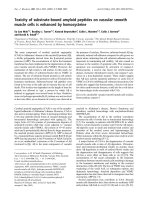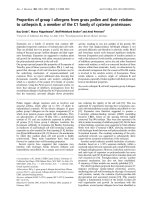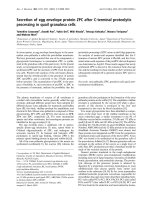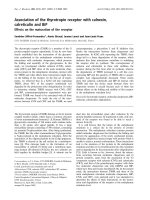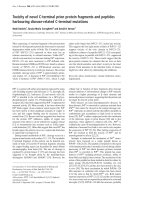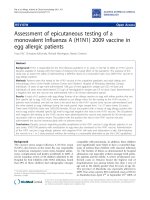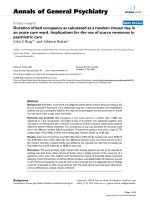Báo cáo y học: "Assessment of knowledge about childhood autism among paediatric and psychiatric nurses in Ebonyi state, Nigeria" doc
Bạn đang xem bản rút gọn của tài liệu. Xem và tải ngay bản đầy đủ của tài liệu tại đây (234.97 KB, 8 trang )
RESEARCH Open Access
Assessment of knowledge about childhood
autism among paediatric and psychiatric
nurses in Ebonyi state, Nigeria
Monday N Igwe
1*
, Anthony C Ahanotu
1
, Muideen O Bakare
2
, Justin U Achor
3
, Chinonyerem Igwe
1
Abstract
Background: There is increasing public and professional awareness of autism spectrum disorders with early
recognition, diagnosis and interventions that are known to improve prognosis. Poor knowledge about childhood
autism among paediatric and psychiatric nurses who are members of multidisciplinary teams that care for such
children may be a major barrier to early interventions that could improve quality of life and prognosis in childhood
autism. Factors that influence knowledge about childhood autism among these nurses are not known. This study
assessed knowledge about childhood autism among paediatric and psychiatric nurses in Ebonyi state, Nigeria and
determined the factors that could be influencing such knowledge.
Methods: Forty specialist paediatric and forty psychiatric nurses, making a total sample of eighty, were randomly
selected from all the health care facilities in Ebonyi state, Nigeria. A socio-demographic questionnaire and
knowledge about childhood autism among health workers (KCAHW) questionnaire were administered to them and
the study was a point survey.
Results: The total mean score on the KCAHW questionnaire among the nurses that participated in the study was
12.56 ± 3.23 out of a total of 19 possible. The mean score for the paediatric nurses was 11.78 ± 3.64 while
psychiatric nurses had mean score of 13.35 ± 2.58. The mean scores in Domain 1 were 6.17 ± 1.75 for the
paediatric nurses and 6.52 ± 1.43 for the psychiatric nurses. The mean scores in Domain 2 were 0.65 ± 0.48 for the
paediatric nurses and 0.80 ± 0.41 for the psychiatric nurses. Domain 3 showed mean scores of 1.97 ± 1.25 for the
paediatric nurses while psychiatric nurses scored 2.62 ± 1.23. Domain 4 yielded the mean scores of 2.97 ± 1.54 and
3.42 ± 0.98 for the paediatric and psychiatric nurses respectively.
There was significant relationship between the total mean score on the KCAHW questionnaire for the two groups
and the area of specialisation of the nurses (t = -2.23, df = 78, p = 0.03) and there was also significant relationship
between previous involvement in managing children with childhood autism as a specialist paediatric or psychiatric
nurse and the total mean score on the KCAHW questionnaire (t = 6.90, df = 78, p = 0.00).
Conclusion: The scores reflect deficits in knowledge about childhood autism among the study cohorts. Paediatric
and psychiatric nurses as members of multidisciplinary teams that care for children with childhood autism are
expected to provide holistic care and adequate counselling to the families of these children. Unfortunately in this
environment, they are not fully equipped with enough knowledge about childhood autism. Education on
childhood autism is therefore needed and can be provided through continuing medical education and
emphasizing childhood autism in their trainin g curriculum. This will enhance early identification and diagnosis of
childhood autism with early interventions that are known to improve prognosis.
* Correspondence:
1
Department of Psychological Medicine, Ebonyi State University Teaching
Hospital Abakaliki, Nigeria
Full list of author information is available at the end of the article
Igwe et al. Child and Adolescent Psychiatry and Mental Health 2011, 5:1
/>© 2011 I gwe et al; licensee BioMed Central Ltd. This is an Open Acc ess article distributed under the terms of the Creative Commons
Attribution License (http://creativecom mons.org/licenses/by/2.0), which permits unrestricted use , distribution, and reproduction in
any medium, provided the original work is properl y cited.
Background
Childhood autism is a pervas ive develop mental disorder
that affects children’s social, communication and beha-
vioural development. There are qualitative impairments
in social interaction, communication with restricted
repetitive and stereotyp ed patterns of behaviour, inter-
ests and activities [1]. Knowledge and awareness about
this condition have been on the increase especially in
the developed countries whereas these remain at a lower
ebb in Nigeria and other sub-Saharan African countries
[2,3]. Lack of knowledge and awareness about childhood
autism is thus a major barrier to improving the health
and wellbeing of children affected by autism in this
environment. This further limits access to care and early
interventions that are known to improve quality of life
and prognosis in children with childhood autism.
Bakare et al [4] had noted that nurses w orking in ter-
tiary health institutions in south - east and south - south
regions of Nigeria scored low on the knowledge about
childhood autism among health workers (KCAHW)
questionnaire and knowledge gap was found to be higher
in domain 3 (symptoms of obsessive and repeated pattern
of behaviour), followed by do main 1 (symptoms of
impairments in social interaction), domain 4 (type of dis-
order childhood autism is and associated co-morbidity)
and domain 2 (symptoms of communication impair-
ments). Knowledge about chi ldhood autism was also sig-
nificantly associated with older age groups, previous
experience managing children with autism spectrum dis-
orders, years of experience as a health worker and area of
specialty with workers in psychiatric facility scoring
higher than those working in paediatric settings.
Another survey showed that the majority of school
nurses are knowledg eable about autism spectrum disor-
ders, including sympto matology and related medications
but are not as knowledgeable concerning communica-
tion skills, behavioural therapies and safety issues [5].
Igwe et al [6] reported that undergraduate medical
students had higher scores on the KCAHW question-
naire followed by undergradu ate nursing and psychology
students scoring the least. They advocated for additional
exposure of the undergraduate psychology st udents to
training curriculum aimed at improving their early
recognition of symptoms and signs of autism spectrum
disorders which is known to improve prognosis.
Earlier on Shah had assessed the awareness about
childhood autism among two hundred and fifty medical
students at different stages of their training. He com-
pared differences between first-year and fourth-year stu-
dents with respect to their knowledge of various aspects
of autism, including diagnosis, cause, symptomatology,
treatment and outcome. Fourth-year students were only
significantly more likely to respond correctly to ques-
tions related to diagnostic criteria and c ore symptoms.
His findings suggest that more emphasis should be
placed on teaching medical students about childhood
autism to enhance early diagnosis and interventions [7].
To assess individual’s beliefs and knowledge about
childhood autism, Stone developed the Autism Survey.
This has been used to compare knowledge and beliefs of
individuals fro m different professional philosophies,
teachers and parents about autism [8]. Stone subse-
quently used the survey to compare the views of paedia-
tricians, clinical psychologists, school psychologists,
speech and language pathologists and autism specialists.
Results indicated that individual disciplines studied dis-
played variations and historic misconc eptions regarding
social, emotional and c ognitive aspects of autism. How-
ever the autism specialists viewed the cognitive abilities
of individuals with autism more realistically than o ther
professionals in the study [9].
In another study that compared the views of parents of
people with autism, teachers and autism specialists, it was
found that parents held some beliefs about autism not
shared by teachers and autism specialists. Parents were
more likely than teachers and autism specialists to believe
that autism was a temporary condition and that with time
the children will overgrow it. Also the parents overesti-
mated the cognitive abilities of children with autism [10].
Greek teachers have been observed to know more
about learning disabiliti es followed by autism and atten-
tion deficit/hyperactivity disorder irrespective of whether
they were special needs or general teachers. The author
called for specialised training of teachers on special
education needs [11].
Poor knowledge of autism spectrum disorders among
physicians and failure to give further information to
caregivers may be a reflection of lack of training in the
wide range of behaviours that occur across the autism
spectrum. This may delay average age of diagnosis and
subsequently early interventions that are established to
be beneficial [12].
Caring for children with childhood autism and other
pervasive developmental disorders requires the services
of professionals like psychi atrists, paediatrician s, nurses,
clinical psychologists among others [13]. Paediatric and
psychiatric nurses are usually members of such multidis-
ciplinary teams.
The most significant role of a nurse in autism recogni-
tion and diagnosis is education. The nurse, the family,
and the patient must all be educated on vari ous aspects
of autism and autistic disorders. This places nurses at a
critical juncture, because they must be in creasingly
knowledgeable, understanding and supportive of the
parents and children afflicted with this condition. The
nurse’s level of understanding of autism spectrum disor-
ders can have a great impact on the prognosis of
children with childhood autism.
Igwe et al. Child and Adolescent Psychiatry and Mental Health 2011, 5:1
/>Page 2 of 8
However, a study found that on ly ten percent of par-
ents had their child’s condition ex plained to them in a
clinical setting [14]. It is uncertain whether this could
be a reflection of poor knowledge and awareness about
childhood autism among paediatric and psychiatric
nurses engaged in caring for children with autism.
Therefore, there is the need to a ssess the level of
knowledge about childhood autism among paediatric
and psychiatric nurses who are usually members of the
multidisciplinary team that care for children with autism
and who also act as educators and advocates for this
group o f children. This study is aimed at assessing base
line knowledge about childhood autism and evaluating
factors that influence such knowledge among paediatric
and psychiatric nurses in Ebonyi State, Nigeria
Methods
Location
Location of the study was Ebonyi S tate, Nigeria. Ebonyi
State is a mainland south-eastern state of Nigeria, inhab-
ited and populated primarily by the Igbo ethnic group.
It is one of the 36 states in Nigeria and one of the 5
states in the south-eastern geopolitical zone of the coun-
try. South-east is one of the 6 geopolitical zones in
Nigeria. Ebonyi state was created in 1996 from the old
Abakaliki division of Enugu state and old Afikpo divi-
sion of Abia state with the capital sited at Abakaliki
which is also the largest city. Ebonyi is primarily an agri-
cultural producing region but also has several solid
mineral resources including huge salt deposits at Uburu
and Okposi, hence it is called ‘The salt of the Nation.’
There are 13 General Hospitals, one located in each of
the 13 local government areas. The Federal Medical
Centre and a State Teaching Hospit al, which are tertiary
health facilities, are located at Abakaliki. There are also
many mission and private hospitals within the state.
Ethical approval
The ethical approval for the study was obtained from
the Institutional Review Board (IRB) of Ebonyi State
University Teaching Hospital Abakaliki, Ebonyi State
Nigeria. Written informed consent was also obtained
from the respondents that participated in the study.
Participants and sampling method
The participants involved in this study were paediatric
and psychiatric nurses who work in health facilities
spread across Ebonyi State. Each had al ready obtained a
diploma in paediatric or psychiatric nursing in addit ion
to a registered nurse certificate. There are about fifty
registered psychiatric nurses and forty three paediatric
nurses working in Ebonyi state, Nigeria. Forty nurses
were randomly selected from each group making a total
sample size of eighty. The study was a point survey.
Materials
Socio-demographic questionnaire
A socio-demographic questionnaire w as used to obtain
information like gender, age, marital status, ethnicity,
durati on of working experience as a specialist nurse and
previous experience managing children with childhood
autism.
Knowledge about childhood autism among health
workers (KCAHW) questionnaire [2]
This is a self-administered questionnai re that was devel-
oped by a team of psychiatrists and clinical psycholo-
gists in 2008 at Enugu, Nigeria. It contains a total of
nineteen questions. The KCAHW questionnaire has
been used in several studies and has been established to
have good test-retest reliability, good overall internal
consistency (cronbach’s alpha value of 0.97) and cultu-
rally valid [ 2]. It is used to assess baseline knowledge
about childhood autism among the health workers. Each
of the nineteen items has three options to choose from
with only one out of the three being correct. The cor-
rect option on each item attracts a score of 1, whereas
the other two incorrect options are scored 0 each.
The KCAHW questionnaire is divided into the follow-
ing four domains:
Domain 1
This domain contains eight items that address the
impairments in social interaction usually found in
children with childhood autism. A maximum score of 8
and minimum score 0 are possible in this domain.
Domain 2
This domain contains only one item that addresses
impairment in the area of communication and language
development, as part of the symptoms seen in children
with childhood autism. A maximum score of 1 and
minimum score of 0 are possible in this domain.
Domain 3
This domain contains four items that address the area
of obsessive and compulsive pattern of behaviour found
in children with childhood autism, a pattern of beha-
viour which ha d been described as restricted, repetitive
and stereotyped. A maximum score of 4 and minimum
score of 0 are possible in this domain.
Domain 4
This domain contains six items that address knowledge
on what type of disorder childhood autism is, possible
co-morbid c onditions and period of onset of childhood
autism in affected children. A maximum score of 6 and
minimum score 0 are possible in this domain.
A maximum total score of 19 and minimum total
score of 0 are possible when the four domain scores are
summed up. The questionnaire and the scoring system
areshowninAppendix1.Themeantotalscoreonthe
KCAHW questionnaire among a particular sample
Igwe et al. Child and Adolescent Psychiatry and Mental Health 2011, 5:1
/>Page 3 of 8
population is a measure of level of knowledge about
childhood autism among that particular population. A
total score of 19, which is the maximum score possible
on the KCAHW questionnaire, indicat es adequate
knowledge of symptoms and signs of autism. This ade-
quate knowledge may enhance early recognition, diagno-
sis, appropriate referral and interventions that a re
known to impro ve prognosis in children with childhood
autism.
Procedure
The socio-demographic and KCAHW questionnaires
were administered to the eighty (forty paediatric and
forty psychiatric) nurses. The quest ionnaires were com-
pleted by the respondents and collected back from them
at the point of administration to prevent them from
consulting study materials or discussing with colleagues
before filling their responses.
Data analysis
The generated data were analysed using Statistical Pack-
age for Social Sciences (SPSS) version 16. The mean
score in each domain and the mean total score were cal-
culated for the two groups of nurses. The mean total
score were related to the socio-demographic variables of
the respondents using independent sample t-test.
Results
A total of eighty (80) nurses consented to participate
in the study, forty being paediatric nurses and forty
psychiatric nurses. There were five (12.5%) male and
thirty five (87.5%) female paediatric nurses while nine-
teen (47.5%) male and twenty one (52.5%) female were
psychiatric nurses. The mean age of the paediatric
nurses was 33.95 ± 7.89 years and 37.25 ± 7 .32 years
for the psychiatric nurses. Nine (22.5%) paediatric
nurses had previous experience nursing children with
childhood autism while thirty one of them (77.5%) had
not been involved in managing children with autism.
Eighteen psychiatric nurse (45%) have participated in
managing children with childhood autism while twenty
two (55%) had previously not been involved. Other
socio-demographic variables of the participants are
showninTable1.
Pattern of distribution of scores on the KCAHW
questionnaire among the nurses
Maximum possible score on the knowledge about child-
hood autism among health workers (KCAHW) question-
naire is ninet een (19) and a minimum score of zero (0).
The questionnaire is divided into domains 1, 2, 3 and 4
with maximum possible scores of 8, 1, 4 and 6 respec-
tively. A minimum score of zero (0) is possible in each
of the four domains [2]. The total mean score on t he
KCAHW questionnaire among the nurses that partici-
pated in the study was 12.56 ± 3.23 out of a total of 19
possible. The mean score for the paediatric nurses was
11.78 ± 3.64 while psychiatric nurses had mean score of
13.35 ± 2.58. The mean total scores in Domain 1, which
is concerned with questions in the area of impairments
in social interaction as found in childhood autism, were
6.17 ± 1.75 for the paediatric nurses and 6.52 ± 1.43 for
the ps ychiatric nurses. The mean total scores in Domain
2 which addresses communication impairments that
often characterized childhood autism were 0.65 ± 0.48
for the paediatric nurses and 0.80 ± 0.41 for the psy-
chiatric nurses. Domain 3, which deals with questions
on obsessive and repetitive behavioural patterns that are
often seen in childhood autism, showed total mean
scores of 1.97 ± 1.25 for the paediatric nurses while psy-
chiatric nurses scored 2.62 ± 1.23. Domain 4 that covers
questions on what type of disorder childhood autism is
and possible associated co-morbidity yielded the total
mean scores of 2.97 ± 1.54 and 3.42 ± 0.98 for the pae-
diatric and psychiatric nurses respectively.
Psychiatric nurses who have had experience of nursing
children with autism scored 15.35 ± 0.86 on the
KCAHW questionnaire while their paediatric colleagues
scored 15.30 ± 1.89. Those who have not had experience
of nursing children with autism scored 10.60 ± 3.32 and
11.87 ± 2.42 for paediatric and psychiatric nurses
respectively.
The mean scores in domains 1, 2, 3, 4 and total mean
score are higher among the psychiatric nurses than the
paediatric nurses indicating that the psychiatric nurses are
more likely to recognise symptoms and signs of autism
than the paediatric nurses. The pattern of distribution of
scores on the KCAHW questionnaire is shown in Table 2.
Factors affecting knowledge about childhood autism
among the nurses
There was significant relationship between the total
mean score on the KCAHW questionnaire and the area
of specialisation o f the nurses (t = -2.23, df = 78, p =
0.03). The paediatric nurses scored 11.78 ± 3.64 as
against mean score of 13.35 ± 2.58 by the psychiatric
nurses. The psychiatric nurses also scored higher than
the paediatric nurses in all the four domains.
Significant relationship was also found between total
mean score on the KCAHW questionnaire and previous
experience nursing children with childhood autism as a
specialist paediatric or psychiatric nurse (t = 6.90,
df = 78, p = 0.00).
Greaternumberofpsychiatricnurseshadexperience
in nursing children diagnos ed as having childhood aut-
ism compared to paediatric nurses. Eighteen psychiatric
nurses (45%) had such experience while onl y nine
(22.5%) of paediatric nurses have been in contact with
Igwe et al. Child and Adolescent Psychiatry and Mental Health 2011, 5:1
/>Page 4 of 8
children who have childhood autism. The mean score
for paediatric nurses who had cared for children with
autism was 15.30 ± 1.89 while the psychiatric nurses
who have had such experience scored 15.35 ± 0.86 on
the KCAHW questionnaire.
There was no significant relationship between age and
total mean score on the KCAHW questionnaire among
the two groups. The m ean age of the paediatric nurses
was 33.95 ± 7.89 years and 37.25 ± 7.32 years for the
psychiatric nurses. There is no significant difference in
the mean ages of the two groups (t = -1.94, df = 78,
p = 0.06). No significant relationship was also found
between the total mea n score on t he KCAHW questionnaire
and duration of work as a specialist nurse (t = -1.66, df = 78,
p = 0.10 ).
Discussion
The total mean score among the two groups of nurses
studied was 12.56 ± 3.23 out of possible score of 19.
This is not significantly different from the score of 12.35
± 4.40 obtained among practising nurses in our earlier
study [4].
Area of specialisation was a factor that influenced
knowledge about childhood autism with psychiatric
nurses scoring higher than the paediatric nurses on the
KCAHW questionnaire. Psychiatric nurses are more
likely to recognise symptoms and signs of childhood
autism compared to paediatric nurses and this will cer-
tainly aid early recognition, diagnosis with prompt inter-
ventions that are known to improve prognosis for
children with childhood autism.
Significant relationship also existed between previous
experience managing children with childhood autism
and scores on the KCAHW questionnaire with those
who said yes to having nursed such children scoring
higher. Chil dren with childhood autism in this environ-
ment are more likely to be brought to psychiatric facil-
ities rather than paediatric facilities probably because of
the associated behavioural problems, epilepsy and learn-
ing disability [4]. Hence psychiatric nurses are mo re
likely to come in contact with children with childhood
autism in this environment.
The variation in knowledge about childhood autism as
seen in this study concurs with significant variations
between specialists in different health care settings
involved in caring for children with autism [4,6,9,15].
No significant association was found between knowl-
edge about childhood autism and number of years of
work as a specialist nurse. There was also no significant
relationship between age of the nurses and scores on
the KCAHW questionnaire. Those who are older and
probably with longer years of experience may not neces-
sarily score higher on the KCAHW questionnaire. This
may not be unconnected with recent upsurge in
Table 1 Socio-demographic variables of the nurses
Socio-demographic
variables Paediatric
nurses
Psychiatric
nurses
Gender
Male 5 (12.5%) 19 (47.5%)
Female 35 (87.5%) 21 (52.5%)
Age (years)
Mean ± SD 33.95 ± 7.89 37.25 ± 7.32
Marital status
Single 16 (40%) 13 (32.5%)
Married 22 (55%) 27 (67.5%)
Divorced/separated 0 (0%) 0 (0%)
Widowed 2 (5%) 0 (0%)
Ethnic group
Igbo 38 (95%) 40 (100%)
Yoruba 1 (2.5%) 0 (0%)
Others 1 (2.5%) 0 (0%)
Religion
Christianity 40 (100%) 37 (92.5%)
Islam 0 (0%) 2 (5%)
Traditional 0 (0%) 1 (2.5)
Duration of work as specialist nurse
(yrs)
5.9 ± 5.5 7.9 ± 5.2
Previous experience nursing children
with autism
9 (22.5%) 18 (45)
Table 2 Pattern of distribution of scores on the KCAHW questionnaire among the nurses
Domains Possible score Paediatric nurses Psychiatric nurses
Domain 1 8 6.17 ± 1.75 6.52 ± 1.43
Domain 2 1 0.65 ± 0.48 0.80 ± 0.41
Domain 3 4 1.97 ± 1.25 2.62 ± 1.23
Domain 4 6 2.97 ± 1.54 3.42 ± 0.98
Mean score by nurses with experience of autism 19 15.30 ± 1.89 15.35 ± 0.86
Mean score by nurses without experience of autism 19 10.60 ± 3.32 11.87 ± 2.42
Total mean score 19 11.78 ± 3.64 13.35 ± 2.58
Igwe et al. Child and Adolescent Psychiatry and Mental Health 2011, 5:1
/>Page 5 of 8
awareness and research in autistic spectrum disorders
[16-18]. This is in contrast with a previous finding
which observed that knowledge about childhood autism
was higher in nurses with 6 to 20 years working experi-
ence and those who are in their fourth decade of life
and above [4].
Childho od neuro-developmental disorders are increas-
ingly being recognised with high demands for earlier
diagnosis and intervention. However the total mean
score of 12.56 ± 3.23 out of a total of 19 possible on the
KCAHW questionnaire by the study group is low and is
a reflection of deficits in knowledge, education and
awareness about childhood autism among the paed iatric
and psychiatric nurses in this environment.
Limitations of the study
The KCAHW questionnaire is fashioned to be self
administered and collec ted immediately. This is aimed
at avoiding consulting study materials or discussing with
other health workers which may influence the responses
of the subjects to questions contained in the question-
naire. Thus the KCAHW questionnaire only gives a
point assessment of knowledge. The questionnaire also
does not assess etiological explanations and other cul-
tural beliefs held by the respondents about childhood
autism.
Conclusion
The scores reflect deficits in knowledge about childhood
autism among the study cohorts. Paediatric and psychia-
tric nurses as members of multidisciplinary teams that
car e for children with childhood autism are expected to
provide holistic care and adequate counselling to the
families of these children. Unfortunately in this environ-
ment, they are not fully equipped with enough knowl-
edge about childhood autism. Education on childhood
autism is therefore needed and can be provided through
continuing medical education and emphasizing child-
hood autism in their training curriculum. This will
enhance early identif ication and diagnosis of childhood
autism with early interventio ns that are known to
improve prognosis.
Appendix 1
Knowledge about Childhood Autism among Health
Workers (KCAHW) Questionnaire
Please do not consult formal text books to answer these
questions.
Thank you for your co-operation.
The following behaviours best describe a child with
childhood autism:
Domain 1
i. Marked impairment in use of multiple non-verbal
behaviours such as eye to eye contact, facia l expression,
body postures and gestures during social interaction?
(A) Don’t Know, (B) Yes, (C) No
ii. Failure to develop peer relationship appropriate for
developmental age?
(A) Don’t Know, (B) Yes, (C) No
iii. Lack of spontaneous will to share enjoyment, inter-
est or activit ies with other peopl e? (A) Don’tKnow,(B)
Yes (C) No
iv. Lack of social or emotional reciprocity? (A) Don’t
Know (B) Yes, (C) No
v. Staring into open space and not focusing on any-
thing specific? (A)Don’t Know, (B) Yes, (C) No
vi. The child can appear as if deaf or dumb? (A) Don’t
Know (B) Yes, (C) No
vii. Loss of interest in the environment and
surroundings?
(A) Don’t Know, (B) Yes, (C) No
viii. Social smile is usually absent in a child with
Autism?
(A)Don’t Know, (B) Yes (C) No
Domain 2
i. Delay or total lack of development of spoken
language?
(A) Don’t Know (B) Yes (C) No
Domain 3
i. Stereotyped and repetitive movement (e.g. Hand or
finger flapping or twisting)?
(A) Don’t Know (B) Yes, (C) No
ii. May be associated with abnormal eating habit?
(A) Don’t Know, (B) Yes, (C) No
iii. Persistent preoccupation with parts of objects?
(A) Don’t Know (B) Yes, (C) No
iv. Love for regimented routine activities? (A) Don’t
Know (B) Yes, (C) No
Domain 4
i. Autism is Childhood Schizophrenia? (A) Don’tKnow
(B) Yes (C) No
ii. Autism is an auto-immune condition? (A) Don’ t
Know (B) Yes (C) No
iii. Autism is a neuro-developmental disorder? (A)
Don’t Know (B) Yes (C) No
iv. Autism could be associated with Mental Retarda-
tion? (A) Don’t Know (B) Yes (C) No
v. Autism could be associated with Epilepsy? (A) Don’t
Know (B) Yes (C) No
vi. Onset of Autism is usually in, (A) Neonatal age, (B)
Infancy, (C) Childhood
Igwe et al. Child and Adolescent Psychiatry and Mental Health 2011, 5:1
/>Page 6 of 8
Scoring of Knowledge about Childhood Autism among
Health Workers (KCAHW) questionnaire
Domain 1
i Marked impairment in use of multiple non-verbal
behaviours such as eye to eye contact, facia l expression,
body postures and gestures during social interaction?
(A) 0 (B) 1 (C) 0
ii Failure to develop peer relationship appropriate for
developmental age? (A) 0 (B) 1 (C) 0
iii. Lack of spontaneous will to share enjoyment, inter-
est or activities with other people?
(A) 0 (B) 1 (C) 0
iv Lack of social or emotional reciprocity? (A) 0 (B) 1
(C)
v Starring into open space and not focusing on any-
thing specific?
(A) 0 (B) 1 (C) 0
vi. The child can appear as if deaf or dumb? (A) 0 (B)
1 (C) 0
vii. Loss of interest in the environment and surround-
ings? (A) 0 (B) 1 (C) 0
viii. Social smile is usually absent in a child with Aut-
ism? (A) 0 (B) 1 (C) 0
Domain 2
i. Delay or total lack of development of spoken lan-
guage? (A) 0 (B) 1 (C) 0
Domain 3
i. Stereotyped and repetitive movement (e.g. Hand or
finger flapping or twisting)?
(A) 0 (B) 1 (C) 0
ii. May be associated with abnormal eating habit? (A)
0 (B) 1 (C) 0
iii. Persistent preoccupation with parts of objects? (A)
0 (B) 1 (C) 0
iv. Love for regimented routine activities? (A) 0 (B) 1
(C) 0
Domain 4
i. Autism is Childhood Schizophrenia? (A) 0 (B) 0 (C) 1
ii. Autism is an auto-immune condition? (A) 0 (B) 0
(C) 1
iii Autism is a neuro-developmental disorder? (A) 0
(B) 1 (C) 0
iv. Autism could be associated with Mental Retarda-
tion? (A) 0 (B) 1 (C) 0
v. Autism could be associated with Epilepsy? (A) 0 (B)
1 (C) 0
vi Onset of Autism is usually in, (A) 0 (B) 0 (C) 1
A total maximum score of 19 and a minimum score of
0 are possible. The average score on the KCAHW ques-
tionnaire among a particular sample population gives an
index level of kno wledge about childhood autism in that
particular population.
Acknowledgements
We thank Miss Patricia Aluu and Miss Lucia N. Otum who assisted us during
the data collection
Author details
1
Department of Psychological Medicine, Ebonyi State University Teaching
Hospital Abakaliki, Nigeria.
2
Child and Adolescent Unit, Federal
Neuropsychiatric Hospital, New Haven, Enugu, Nigeria.
3
Drug Unit, Federal
Neuropsychiatric Hospital, New Haven, Enugu, Nigeria.
Authors’ contributions
CI was involved in collection of data while MNI was involved in writing the
initial draft of the manuscript and data analysis. All the authors contributed
to the conception of the study and were involved in writing and revising
the manuscript. All the authors read and approved the final draft of the
manuscript.
Competing interests
The authors declare that they have no competing interests.
Received: 6 October 2010 Accepted: 9 January 2011
Published: 9 January 2011
References
1. American Psychiatric Association: Diagnostic and Statistical Manual of
Mental Disorders. Washington, DC;, 4 1994.
2. Bakare MO, Ebigbo PO, Agomoh AO, Menkiti NC: Knowledge about
childhood autism among health workers (KCAHW) questionnaire:
description, reliability and internal consistency. Clinical Practice and
Epidemiology in Mental Health 2008, 4:17.
3. African Network for the Prevention and Protection against Child Abuse and
Neglect (ANPPCAN), Nigeria Chapter: Communiqué on a project to
increase the level of awareness on autism and develop a mechanism for
care and support of children with autism in Enugu State, South Eastern
Nigeria. 2007.
4. Bakare MO, Ebigbo PO, Agomoh AO, Eaton J, Onyeama GM, Okonkwo KO,
Onwukwe JU, Igwe MN, Orovwigo AO, Aguocha CM: Knowledge about
childhood autism and opinion among health care workers on
availability of law caring for the needs and rights of children with
childhood autism and other developmental disorders in Nigeria. BMC
Pediatr 2009, 9:12.
5. Strunk JA: School nurses’ knowledge of autism spectrum disorders. J Sch
Nurs 2009, 6:445-452.
6. Igwe MN, Bakare MO, Agomoh AO, Onyeama GM, Okonkwo KO: Factors
influencing knowledge about childhood autism among final year
undergraduate medical, nursing and psychology students of University
of Nigeria, Enugu State, Nigeria. Italian Journal of Pediatrics 2010, 36:44.
7. Shah K: Research in brief: what do medical students know about autism?
Autism 2001, 5(2):127-133.
8. Campbell DG, Reichle NC, Van Bourgondien ME: The autism survey: An
evaluation of reliability and validity. Journal of Autism and Developmental
Disorders 1996, 26(6):621-634.
9. Stone WL: Cross-discliplinary perspectives on autism. Journal of Pediatric
Psychology 1987, 12:615-630.
10. Stone WL, Rosenbaum JL: A comparison of teachers and parents views of
autism. Journal of Autism and Developmental Disorders 1988, 8:403-414.
11. Kalyva E: Special Education: what do Greek teachers know about
learning disability, autism and attention deficit/hyperactivity disorder? In
International Encyclopedia of Rehabilitation Edited by: Stone JH, Blouin M
2010.
12. Rhoades RA, Scarpa A, Salley B: The importance of physician knowledge
of autism spectrum disorder: results of a parent survey. BMC Pediatr
2007, 7:37.
13. Gelder MG, Lopez-Ibor JJ Jr, Andeasan NC: New Oxford textbook of
psychiatry. Oxford University Pres London; 2003.
14. Howlin P, Moore A: Diagnosis of autism: A survey of over 1200 patients
in the UK. Autism 1997, 1:135-162.
15. Heidgerken AD, Geffken G, Modi A, Frakey L: A survey of autism
knowledge in a health care setting. J Autism Dev Disord 2005,
35(3):323-330.
Igwe et al. Child and Adolescent Psychiatry and Mental Health 2011, 5:1
/>Page 7 of 8
16. Lian WD, Ho SKY, Yeo CL, Ho LY: General practitioners’ knowledge on
childhood developmental and behavioural disorders. Singapore Med J
2003, 44(8):397-403.
17. Fombonne E: The prevalence of autism. JAMA 2003, 289:87-89.
18. Wing L, Potter D: The epidemiology of autistic spectrum disorders: Is the
prevalence rising? Mental Retardation and Developmental Disabilities
Research Reviews 2002, 8:151-161.
doi:10.1186/1753-2000-5-1
Cite this article as: Igwe et al.: Assessment of knowledge about
childhood autism among paediatric and psychiatric nurses in Ebonyi
state, Nigeria. Child and Adolescent Psychiatry and Mental Health 2011 5:1.
Submit your next manuscript to BioMed Central
and take full advantage of:
• Convenient online submission
• Thorough peer review
• No space constraints or color figure charges
• Immediate publication on acceptance
• Inclusion in PubMed, CAS, Scopus and Google Scholar
• Research which is freely available for redistribution
Submit your manuscript at
www.biomedcentral.com/submit
Igwe et al. Child and Adolescent Psychiatry and Mental Health 2011, 5:1
/>Page 8 of 8
